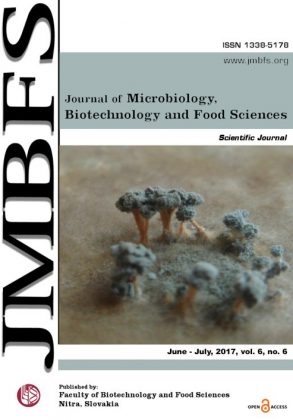POTENTIAL OF SELECTED SSR MARKERS FOR IDENTIFICATION OF MALTING BARLEY GENOTYPES
DOI:
https://doi.org/10.15414/jmbfs.2017.6.6.1276-1279Keywords:
Barley, Genetic diversity, Simple sequence repeat (SSR), DNA markerAbstract
Cereals are main part of human nutrition and strategic resources. Thousands of barley varieties are used in food industry and especially for the production of malt in the brewing industry. In the present study, we were focused on utilization of SSR markers for differentiation and characterization of different barley genotypes. Barley collection was analyzed by 4 pure and 1 compound markers. Using STMS method we have revealed significant polymorphism. A total of 27 alleles were detected among 24 varieties with an average of 5.4 alleles per locus. Average values for index of diversity (DI), polymorphic information content (PIC) were 0.767, 0.756 respectively. The highest level of polymorphism was detected with SSR marker Bmag 0222 (7 alleles) which also revealed one heterozygous variety. Dendrogram was created by hierarchic cluster analysis using UPGMA algorithm on the basis of detected alleles. Analyzed genotypes were divided into three clusters so it can be used to study genetic relations among collection of analyzed barley varieties.Downloads
Download data is not yet available.
Downloads
Published
2017-06-01
How to Cite
Tomka, M., Urminská, D., Chňapek, M., & Gálová, Z. (2017). POTENTIAL OF SELECTED SSR MARKERS FOR IDENTIFICATION OF MALTING BARLEY GENOTYPES. Journal of Microbiology, Biotechnology and Food Sciences, 6(6), 1276–1279. https://doi.org/10.15414/jmbfs.2017.6.6.1276-1279
Issue
Section
Biotechnology
License
Copyright (c) 2017 Marián Tomka, Dana Urminská, Milan Chňapek, Zdenka Gálová

This work is licensed under a Creative Commons Attribution 4.0 International License.
All papers published in the Journal of Microbiology, Biotechnology and Food Sciences are published under a CC-BY licence (CC-BY 4.0). Published materials can be shared (copy and redistribute the material in any medium or format) and adapted (remix, transform, and build upon the material for any purpose, even commercially) with specifying the author(s).





